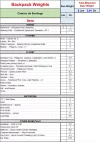Hi, Sally....
I doubt if it is an issue of poor choices at all

In previous threads I have mentioned that gear and clothing choices are mostly affected by frequency of use and purpose. Sort of an algorithm of decision making which includes a Dollar/Euro/Currency per mile/Km ratio. If one is only going to walk. For example, if one is only looking to walk Camino, which for the Frances is about 800 Km/500 miles, would one spend the same amount of money purchasing ultralight gear as someone like myself who backpacks many hundreds of miles throughout every year?
Realistically, the trade-off of expense vs weight is a real concern to most heading out on Camino, who will decide that budgets favor saving money.
For gear choices, it is a matter of knowledge. I am very familiar with most gear offerings by a large number of manufacturers. Some of that is because i am hired to test backpacking gear and clothing. Some of that is because I have been backpacking and mountaineering for decades and have a lot of practical experience.
A person who is deciding to walk a Camino, but who has never been backpacking before is faced with not only trying to figure out what s/he needs clothing and equipment wise, but has no real knowledge of the breadth and depth of clothing and gear options. They will be struggling to make decisions on a backpack, for example, without having ever worn a backpack for a multiday walk. They do not know what will work for themselves. Most of what will inform their decisions are what other Forum members say worked well for them, not practical and hand's on experience with a broad range of manufacturers and models.
So if those of us who have a broad experiential range of knowledge from the outdoors and backpacking voice an opinion as to an ultra lightweight choice of a backpack, which is not a well known brand, it is a small voice among many.
The other factor is that if a large number of folks have a positive experience with a backpack, but that specific backpack is heavier than a less well known model which performs just as well but which they have not tried, then a recommendation will be limited in scope. That does not mean that the backpack recommended is bad, it only means that the knowledge that an equivalent lighter choice is available is missing. The same analogy applies to clothing, sleeping gear, etc.
As a practical application of the above, someone like myself will have the same type of gear as a less experienced walker, but because of my experience my gear will weigh less by 50%, or more.
In summary, someone having a backpack load which weighs more than my pack is less about 'bad' choices, but about knowledge and budget. And keep in mind that my pack load will weigh more if I decide that I want to add other items based on need or want.
As an example, this last September on my second Camino, I had decided to do a full step-by-step video recording of my walk over the Napoleon Route fro SJPdP to Roncesvalles. To do that 10+ hours of continuous recording added nearly 5 pounds to my normal 9.5 pounds. After Roncesvalles, though, I mailed home my video gear so that I went back to my normal load.
But choices of gear, what one decides is a necessity, packing for fear, etc, all affect how heavy one's pack will be. Because of my experience, I am confident that I can face most walking related issue regarding weather, injury, comfort level, etc with much less than those with less experience.
Experience leads to knowledge, leads to confidence, leads to needing less. Keep this in mind when looking at my packing list

Also, I dropped the Xero sandals from this list and replaced them with a homemade 1.5 ounce pair of shower shoes. Adding a liter of water to the pack adds about 2 pounds; so minus 9.5 ounces from the list, and then add 2 pounds.
View attachment 50690



















